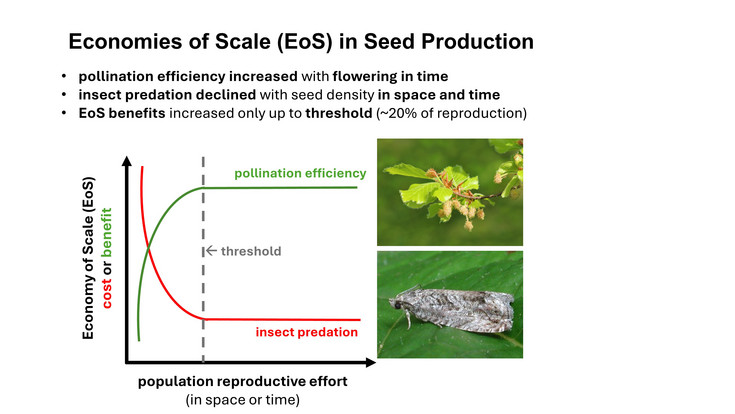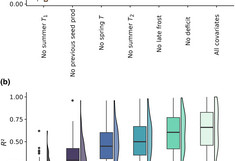Positive spatial and temporal density-dependence drive early reproductive economy-of-scale effects of masting in a European old-growth forest community

Mario B. Pesendorfer, Michał Bogdziewicz, Iris Oberklammer, Ursula Nopp-Mayr, Jerzy Szwagrzyk, Georg Gratzer
- Masting, the spatial synchronization of interannual variation in seed production, can enhance reproductive efficiency through positive density-dependent processes (DD) that result in economies of scale (EOS), such as decreased pollen limitation and predator satiation in years of high reproduction.
- While the general occurrence of such EOS effects has been documented for masting species, few studies simultaneously investigated how spatial and temporal variation in reproduction affects pollination and predation. Furthermore, it is unclear whether the same mechanisms apply to co-occurring species with different levels of conspecific density, pollen limitation, and seed defences.
- Here, we use a long-term dataset with high spatial resolution of seed production of European beech (Fagus sylvatica), Norway spruce (Picea abies), and silver fir (Abies alba) in a primeval montane forest to investigate the relationship between reproductive effort, pollination efficiency and predispersal predation by insects.
- We found that, along the temporal axis, the proportion of sound (fertilized and unpredated) seeds correlated positively with annual seed production over the 14-year study period in all three species, most strongly in beech and only weakly in silver fir. Moreover, the results show that in beech, spatial seed density interacts with plot-wide annual seed rain to enhance DD effects on seed predation, suggesting additive effects of synchronous reproduction on fitness benefits.
- Synthesis: For both pollination and predispersal predation in beech and spruce, the strongest DD effects occur at low levels of reproduction and quickly reach asymptotes at higher levels, suggesting the presence of thresholds in different EOS mechanisms. As variability and synchrony in mast-seeding are expected to decline with climate change, EOS effects driven by DD may remain stable until the threshold is reached, at which sudden declines would result in devastating effects on the availability of viable seeds for germination and recruitment.
Here the link to the full article: https://besjournals.onlinelibrary.wiley.com/doi/10.1111/1365-2745.14368
Check out the blog post at the Journal of Ecology
https://jecologyblog.com/2024/07/30/why-it-makes-sense-for-trees-to-reproduce-in-synchrony/
FORSEE Publications
-

Fig. 2 Sequential model of weather effects on seed production in European beech. A) Variance explained (R2) of cumulative additive model, B) Root-mean squared error (RMSE).
Journé V, Hacket-Pain A, Oberklammer I, Pesendorfer MB, Bogdziewicz M (2023) Forecasting seed production in perennial plants: identifying challenges and charting a path forward. New Phytologist 239: 466-476.
